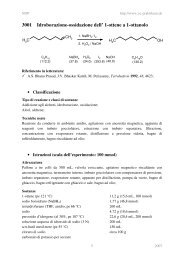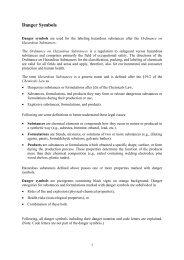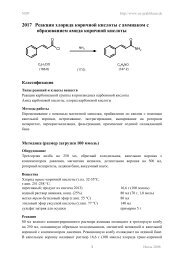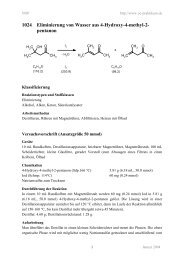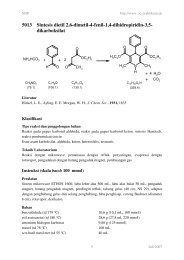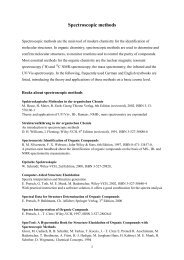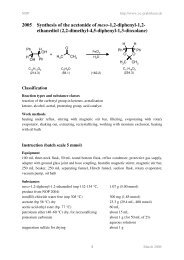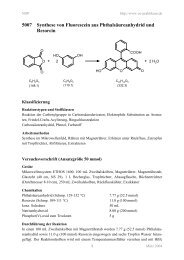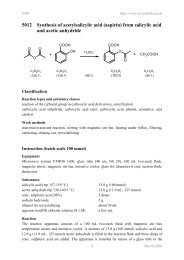Synthesis instructions as PDF file for printing - kriemhild
Synthesis instructions as PDF file for printing - kriemhild
Synthesis instructions as PDF file for printing - kriemhild
Create successful ePaper yourself
Turn your PDF publications into a flip-book with our unique Google optimized e-Paper software.
NOP http://www.oc-praktikum.de<br />
5013 <strong>Synthesis</strong> of 2,6-dimethyl-4-phenyl-1,4-dihydropyridine-<br />
3,5-dicarboxylic acid diethyl ester<br />
NH 4 HCO 3<br />
+<br />
+ 2<br />
O<br />
OC 2 H 5<br />
1<br />
H 5 C 2 O<br />
O O<br />
OC 2 H 5<br />
H O O CH3 H3C N<br />
H<br />
CH3 + 4 H2O CH5NO3 C7H6O C6H10O3 C19H23O4N + CO2 (79.1) (106.1) (130.1)<br />
(329.4)<br />
Literature<br />
Hinkel, L. E., Ayling, E. E. Morgan, W. H., J. Chem. Soc., 1931, 1835<br />
Cl<strong>as</strong>sification<br />
Reaction types and substance cl<strong>as</strong>ses<br />
reaction of the carbonyl group in aldehydes, reaction of the carbonyl group in ketones,<br />
Hantzsch synthesis, ring closure reaction<br />
carboxylic acid ester, aldehyde, ketone, heterocycle, aromatics<br />
Work methods<br />
microwave-<strong>as</strong>sisted reaction, heating under reflux, filtering, evaporating with rotary<br />
evaporator, stirring with magnetic stir bar, draining of g<strong>as</strong>es<br />
Instruction (batch scale 100 mmol)<br />
Equipment<br />
Microwave system ETHOS 1600, 500 mL two-neck fl<strong>as</strong>k, 50 mL round bottom fl<strong>as</strong>k,<br />
magnetic stirrer, magnetic stir bar, reflux condenser, gl<strong>as</strong>s tube (40 cm, NS 29), adapter with<br />
ground gl<strong>as</strong>s joint and hose coupling, suction fl<strong>as</strong>k, 2 w<strong>as</strong>h bottles, Buechner funnel (diameter<br />
6 cm), rotary evaporator, desiccator<br />
Substances<br />
benzaldehyde (bp 179 °C) 10.6 g (10.1 mL, 100 mmol)<br />
acetoacetic acid ethyl ester (bp 180 °C) 28.6 g (27.8 ml, 220 mmol)<br />
ammonium hydrogen carbonate 9.88 g (125 mmol)<br />
ethanol (bp 78 °C) 100 mL<br />
tert-butyl methyl ether (bp 55 °C) 40 mL<br />
March 2006
NOP http://www.oc-praktikum.de<br />
Reaction<br />
The reaction apparatus consists of a 500 mL two-neck fl<strong>as</strong>k with magnetic stir bar, electronic<br />
temperature control and reflux condenser. The reflux condenser is connected with an adapter<br />
with ground gl<strong>as</strong>s joint and hose coupling and a hose <strong>for</strong> draining of the g<strong>as</strong>es <strong>for</strong>ming during<br />
reaction. The hose is connected with an empty safety w<strong>as</strong>h bottle which is connected with a<br />
w<strong>as</strong>h bottle, filled with about 300 mL of water.<br />
10.6 g (10.1 mL, 100 mol) benzaldehyde, 28.6 g (27.8 mL, 220 mmol) acetoacetic acid ethyl<br />
ester, 9.88 g (125 mmol) ammonium hydrogen carbonate and 40 mL ethanol are filled in the<br />
reaction fl<strong>as</strong>k. The reaction apparatus is installed with the gl<strong>as</strong>s tube in the micro wave system<br />
(see "Technical <strong>instructions</strong>: Standard refluxing apparatus <strong>for</strong> micro wave systems") and<br />
treated <strong>for</strong> 40 minutes: The mixture is heated with 900 W in 2 minutes to 80 °C and this<br />
temperature is kept <strong>for</strong> 20 minutes with 400 W, then with 700 W with a temperature ramp in<br />
3 minutes from 80 °C to 88 °C until continuously refluxing and this temperature is kept <strong>for</strong><br />
15 minutes with 500 W. Afterwards the reaction mixture is further stirred <strong>for</strong> 30 minutes<br />
without additional energy supply.<br />
Work up<br />
Until its complete crystallization the cooled reaction mixture is kept in the cooler overnight<br />
where the crude product crystallizes <strong>as</strong> light-yellow solid material. The crude product is finely<br />
chopped in the fl<strong>as</strong>k and sucked off over a Buechner funnel. On the Buechner funnel it is<br />
w<strong>as</strong>hed with 10 mL, 20 mL and 10 mL ethanol and sucked off.<br />
A second product fraction can be gained from the filtrate:<br />
The solvent is evaporated from the filtrate at the rotary evaporator and the remaining oily<br />
crystalline p<strong>as</strong>te is stirred with 30 mL tert-butyl methyl ether <strong>for</strong> 15 minutes. The solid<br />
material is filtered over a folded filter paper and w<strong>as</strong>hed repeatedly with 10 mL tert-butyl<br />
methyl ether. The yellowish residue is transferred in a 50 mL fl<strong>as</strong>k and stirred with 20 mL<br />
ethanol <strong>for</strong> 15 minutes, then sucked off over a Buechner funnel, w<strong>as</strong>hed with less ethanol and<br />
sucked off again.<br />
The two product fractions are dried in the desiccator at reduced pressure.<br />
Yield (total): 21.1 g (64.1 mmol, 64%); mp 156-158 °C; GC-purity of both fractions 100%.<br />
The first product fraction is colourless and finely crystalline, the second pale-yellow.<br />
Comments<br />
An aquaeous solution of ammonia w<strong>as</strong> not used <strong>for</strong> the reaction since a high water<br />
concentration in the system is disadvantageous <strong>for</strong> the reaction. From the used ammonium<br />
hydrogen carbonate in the temperature area of 80 °C the ammonia necessary <strong>for</strong> the reaction<br />
is rele<strong>as</strong>ed. A larger excess of ammonia does not lead to an incre<strong>as</strong>e in yield.<br />
2<br />
March 2006
NOP http://www.oc-praktikum.de<br />
W<strong>as</strong>te management<br />
Recycling<br />
The evaporated ethanol is collected and redistilled.<br />
W<strong>as</strong>te disposal<br />
W<strong>as</strong>te Disposal<br />
tert-butyl methyl ether filtrate organic solvents, halogen free<br />
ethanol filtrates and w<strong>as</strong>hing solutions organic solvents, halogen free<br />
Time<br />
2 - 3 hours (without drying time)<br />
Break<br />
Be<strong>for</strong>e work-up<br />
After isolation of the first product fraction<br />
Degree of difficulty<br />
E<strong>as</strong>y<br />
Analytics<br />
GC<br />
Sample preparation:<br />
50 mg of a sample are dissolved in 1 mL dichlormethane from which 3 µL are injected.<br />
GC-conditions:<br />
column: HP-5; length 30 m, internal diameter 0.32 mm, film 0.25 µm<br />
inlet: split injection 194:1<br />
carrier g<strong>as</strong>: H2, pre-column pressure 31 kPa<br />
oven: 3 min isotherm at 50 °C, afterwards with 8 °C/min to 320 °C<br />
detector: 300 °C<br />
Percent concentration w<strong>as</strong> calculated from peak are<strong>as</strong>.<br />
GC of the pure product<br />
Retention time of the product = 29 min. No impurities were detected.<br />
3<br />
March 2006
NOP http://www.oc-praktikum.de<br />
1 H NMR spectrum of the product (300 MHz, CDCl3)<br />
7.3<br />
7.0<br />
7.2<br />
(ppm)<br />
7.1<br />
6.0<br />
5.0<br />
H 5 C 2 O<br />
9<br />
8<br />
4.1<br />
(ppm)<br />
4.0<br />
(ppm)<br />
δ (ppm) Multiplicity Number of H Assignment<br />
1.22 t 6 CH2-CH3<br />
2.32 s 6 CH3 (at the ring)<br />
4.08 m 4 CH2-CH3<br />
4.99 s 1 4-H<br />
5.72 s 1 NH<br />
7.07-7.30 m 5 CH arene<br />
4.0<br />
O O<br />
3<br />
10<br />
7<br />
4<br />
1<br />
H C 2<br />
3 N 6 CH3 H<br />
11<br />
12<br />
5<br />
3.0<br />
OC 2 H 5<br />
4<br />
2.0<br />
1.0<br />
March 2006
NOP http://www.oc-praktikum.de<br />
13 C NMR spectrum of the product (300 MHz, CDCl3)<br />
160<br />
140<br />
120<br />
100<br />
(ppm)<br />
δ (ppm) Assignment<br />
167.65 C=O<br />
147.76 C-7<br />
143.87 C-2, C-6<br />
127.99, 127.82 C-8, C-12, C-9, C11<br />
126.09 C-10<br />
104.14 C-3, C-5<br />
59.72 O-CH2-<br />
39.62 C-4<br />
19.55 CH3 at the ring<br />
14.24 CH3-CH2-<br />
76.5-77.5 solvent<br />
80<br />
5<br />
60<br />
40<br />
H 5 C 2 O<br />
20<br />
9<br />
8<br />
O O<br />
3<br />
10<br />
7<br />
4<br />
1<br />
H3C 2 N 6 CH3 H<br />
11<br />
12<br />
5<br />
OC 2 H 5<br />
March 2006
NOP http://www.oc-praktikum.de<br />
IR-spectrum of the product (KBr)<br />
%T<br />
16,6<br />
16<br />
15<br />
14<br />
13<br />
12<br />
11<br />
10<br />
9<br />
8<br />
7<br />
6,4<br />
3340,57<br />
3057,97<br />
2898,55<br />
3239,13 2985,50<br />
Hantzsch-Synthese<br />
Zielprodukt<br />
1689,27<br />
4000,0 3000 2000 1500 1000 450,0<br />
cm-1<br />
1653,14<br />
1486,94<br />
6<br />
1454,42<br />
(cm -1 ) Assignment<br />
3340 N-H- valence<br />
3080, 3060 C-H-valence, arene<br />
2985, 2900 C-H-valence, alkane<br />
1690 C=O-valence, ester<br />
1655 C=C-valence, alkene<br />
1490 C=C-valence, arene<br />
1324,35<br />
1371,32<br />
1248,48<br />
1299,06<br />
1165,38<br />
1208,74<br />
1122,02<br />
1049,76<br />
1020,86<br />
1089,51<br />
829,37<br />
735,43<br />
771,56<br />
702,91<br />
500,58<br />
637,87<br />
March 2006



